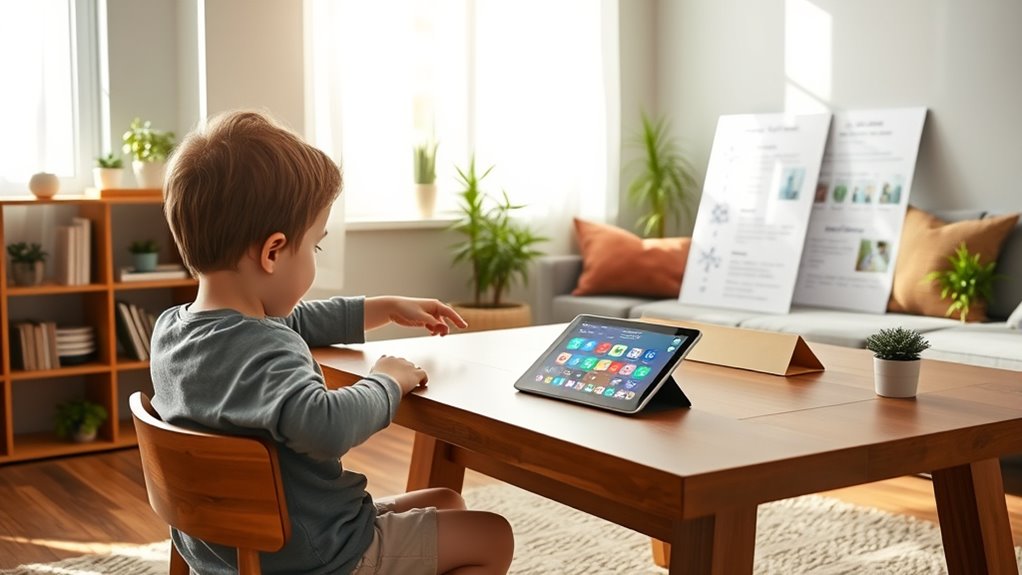To manage screen time effectively across ages, set age-appropriate limits and prioritize face-to-face interactions, outdoor play, and other activities. For toddlers, focus on active, hands-on learning with minimal screen exposure, while preschoolers and school-aged kids benefit from educational content and routines with designated screen-free times. Teenagers need guidance on responsible use and setting boundaries around social media. Following these guidelines helps foster healthy habits—stay tuned to discover more practical tips to balance screen use with daily life.
Key Takeaways
- Tailor screen time limits according to age, prioritizing active play and face-to-face interactions for young children.
- Use parental controls and routines to set appropriate daily limits and ensure content suitability for each age group.
- Encourage outdoor activities and offline hobbies alongside screen use to promote a healthy balance.
- Establish screen-free zones and times, especially during meals and before bedtime, for all age groups.
- Promote open communication about responsible digital behavior and online safety as children grow older.
Understanding Age-Appropriate Screen Time Recommendations

Understanding age-appropriate screen time recommendations is essential for helping children develop healthy habits. You should prioritize regular digital detox periods to give your child a break from screens, promoting physical activity and face-to-face interactions. Monitoring screen time is key; set limits based on your child’s age to prevent excessive use. For young children, aim for limited screen exposure, focusing instead on play and learning. As they grow, gradually introduce more screen time but ensure it remains balanced with other activities. Remember, consistency in enforcing these guidelines helps children understand boundaries. By actively managing screen time and encouraging digital detox, you foster healthier habits that support their overall development and well-being. Incorporating guidelines from reputable sources can further aid in establishing effective screen time management strategies.
Screen Time Guidelines for Toddlers (Ages 0-2)

For toddlers aged 0-2, limiting screen time is essential to support healthy development. Excessive screen exposure can interfere with their physical activity, language skills, and social interactions. Instead, focus on playtime alternatives that promote exploration and sensory experiences, like reading, singing, or tummy time. As a parent, your monitoring is vital; keep screens out of bedrooms and avoid screen use during meals or naps. Establish routines that prioritize face-to-face interactions and hands-on play. Remember, young children learn best through direct engagement, so your active involvement makes a significant difference. Additionally, understanding how contrast ratio impacts image quality can help parents choose appropriate visual environments for their children, fostering better learning and engagement. By setting clear boundaries and encouraging active play, you help foster their growth and development during these formative years.
Managing Screen Time for Preschool and Elementary-Aged Children (Ages 3-12)

As children grow from toddlers into preschoolers and elementary students, managing their screen time becomes increasingly important to support healthy habits and balanced development. During this stage, focus on fostering digital literacy by encouraging educational content that promotes learning and creativity. Use parental controls to set appropriate time limits and filter out unsuitable material, giving you peace of mind. Establish routines that include designated screen-free times, like meals and bedtime, to ensure balance. Encourage outdoor play, reading, and other offline activities alongside screen use. Regularly monitor your child’s screen activity to ensure it’s age-appropriate and aligned with your family’s values. By actively managing screen time, you help your child develop healthy digital habits that will serve them well as they grow. Incorporating age-appropriate content can further support their developmental needs and interests.
Setting Boundaries for Teenagers and Adolescents (Ages 13-18)

Setting boundaries for teenagers and adolescents can be challenging, but clear limits help them develop responsible digital habits. You should encourage open conversations about digital etiquette and respect online boundaries. Establish rules around social media boundaries, such as no sharing personal information or engaging in harmful interactions. Make sure your teen understands the importance of respectful communication and privacy. Set time limits for social media use to prevent excessive screen time, and discuss the impact of digital footprints. Encourage them to think critically before posting or commenting, fostering responsible online behavior. By setting these boundaries, you help your teen navigate the digital world safely and respectfully, building skills that will serve them well as they grow. Additionally, incorporating discussions about skin health can promote overall well-being and awareness of self-care practices.
Practical Tips for Balancing Screen Use and Other Activities

Balancing screen time with other activities requires intentional planning and everyday habits. To prevent excessive use, schedule regular digital detox periods where you unplug and disconnect from screens. Use this time to engage in outdoor activities like walking, biking, or playing sports, which refresh your mind and body. Set specific limits on daily screen use, especially during mealtimes and before bed, to create healthier boundaries. Encourage activity variety by mixing screen-based tasks with hobbies such as reading or crafting. Establish tech-free zones in your home to reduce temptation. By consciously integrating outdoor activities and digital detox moments into your routine, you help foster a balanced lifestyle that promotes well-being and reduces reliance on screens.
Frequently Asked Questions
How Do Screen Time Guidelines Vary Across Different Countries?
You’ll notice that screen time guidelines vary across countries due to cultural influences and policy differences. Some nations emphasize strict limits to promote outdoor play and face-to-face interactions, while others are more relaxed, focusing on digital literacy. These differences shape how parents and educators set boundaries, reflecting each country’s values and priorities. Ultimately, understanding these variations helps you adapt your approach to your child’s needs within your cultural context.
What Are the Long-Term Impacts of Excessive Screen Time on Children’s Health?
Excessive screen time can subtly affect your child’s health over time, leading to digital dependency and potential eye health issues. Long-term, it might influence their sleep patterns, reduce physical activity, and impair social skills. While technology offers benefits, balancing screen use helps prevent these concerns, ensuring your child develops healthy habits. Encouraging outdoor play and setting boundaries promotes overall well-being and resilience against the impacts of too much screen exposure.
How Can Parents Effectively Monitor and Enforce Screen Time Limits?
You can effectively monitor and enforce screen time limits by establishing clear digital boundaries through consistent parental strategies. Set specific rules about when and where devices are used, and use parental controls to manage access. Regularly discuss the importance of balanced screen time, involve your child in creating rules, and model good digital habits yourself. These steps help your child understand limits and develop healthy tech habits.
Are There Specific Types of Content That Are More Beneficial or Harmful?
Research shows children who engage with educational content tend to develop better problem-solving skills, while violent media can increase aggressive behavior. You should prioritize beneficial content, like educational videos and interactive apps, and limit exposure to violent media. Monitoring what your kids watch helps them learn positively and reduces harmful effects. By choosing quality content, you support their development and keep their screen time safe and productive.
What Role Should Educators Play in Managing Student Screen Time?
As an educator, you should set clear classroom policies that promote healthy screen time habits and foster digital literacy. You play an essential role in guiding students to use technology responsibly, encouraging critical thinking about content, and balancing screen use with offline activities. By actively managing screen time, you help students develop skills to navigate digital environments safely and effectively, ensuring technology enhances learning rather than hinders it.
Conclusion
By following these guidelines, you can help your child navigate the digital world safely, like a steady captain steering through choppy waters. Remember, setting healthy boundaries isn’t about restriction, but fostering a balanced life where screen time enhances learning and connection. With mindful choices, you’ll create an environment where technology serves as a tool for growth, not a barrier to meaningful experiences. Your guidance lights the way toward a brighter, healthier future for your child.









